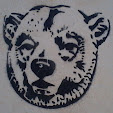Mostly Jon's Attwood's blurb and imagery tonight, so I'll load the images and then divide his potted history between them (with my italics), as a potted history, more than something more specific, I have a K's three-wheeled wagon in HO injection-moulded plastic, which makes a great Boer War 'gun wagon', which I keep meaning to Blog one day!
*****************************************
Firstly, a pic of ABS packaging, as far as I know packaging is the
only way of telling these from the K's versions, I suspect that they may
have been cast by Mr Swain for K's anyway.
Then a few K's (I think) loose castings and a page from their catalogue showing their range.
N.
& K.C. Keyser ltd. is an iconic company in model railway history,
they are generally credited with producing the first whitemetal loco kit
(a GWR 0-4-2 t in 1957).
N. Keyser, often known as Pop was a
German immigrant who had a tobacconist shop in Uxbridge Road, London.
His son Ken made scratchbuilt model locos, which were displayed in their
shop window from 1946.
Ken saw a jewellers centrifugal casting machine and was quick to
exploit it's potential for making small components for his locos, these
component packs were sold from the family shop by mail order, and
quickly were picked up by model railway retailers such as W. & H.
(Walkers and Holtzpfaffel) and Hamblings. He soon moved on to wagon kits
and in '57 the aforementioned loco. Apparently Bob Wills (Wills' kits)
was at an advanced stage in introducing his loco kit, but K's just
beat him to release the kit at the Model Railway club show. K's kits
were a complete package with wheels, motor wiring and all included,
Wills (and most other railway kit manufacturers since) expected the
modeller to source these bits separately. As the range grew the
company moved to a purpose built factory near Willesden Junction
station, where they remained for 12 years Pop Keyser passed away in
1966, leaving the company in the hands of Ken and his two sons, Melvyn
and Graham. Further expansion saw them move to Banbury, where they
started producing injection moulded plastic parts and kits, and
subcontracting some of the metal production to outside agents. The first plastic releases I am aware of were wheel centres in 1970. Although
manufacturing in many scales, they sold off their entire TT scale (3mm
ft) range in 1977, to ABS. After 1983 many of their products appeared
under different brand names, though I don't know if these were sold or
subcontracted.
Ken died in 1989, and most of the range was sold to HMC Group, marketed under Autocom and Nu-cast brands.
I
don't know what the early packaging was like, but in their heyday K's
castings were shrink-wrapped onto a backing card, sometimes so tightly
that it bent the models, not really an issue with the soft whitemetal
castings, but it did sometimes bend the shafts on the motors, a problem exacerbated by the effects of heat and light on the packaging.
Eventually the motors were put in a cardboard tube section before
wrapping, and some of the smaller components in a plastic box to prevent
the problem.
******************************************
In addition to Jon's images, I scanned this from one of the earlier catalogues, and it would appear that a certain amount of artistic licence has been employed in the rendering of the figures! Many thanks to Jon for all that!







2 comments:
I should have added 00 scale when I referred to K's making the first whitemetal loco kit, they had, of course been around in larger scales for some while. my mistake.
Jon
Cheers Jon, hardly a crime, and thank you for the article!
H
Post a Comment